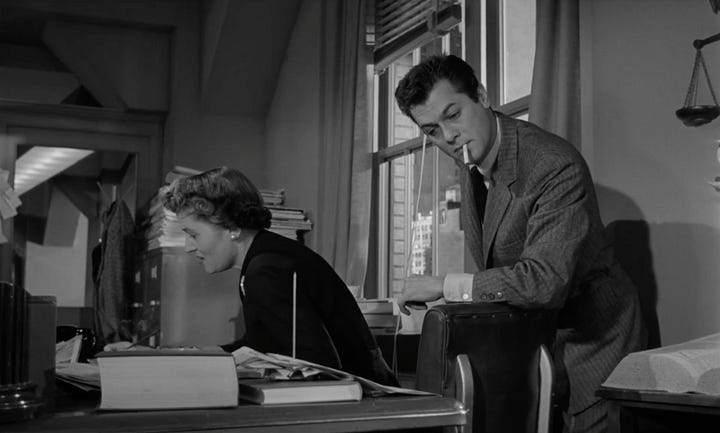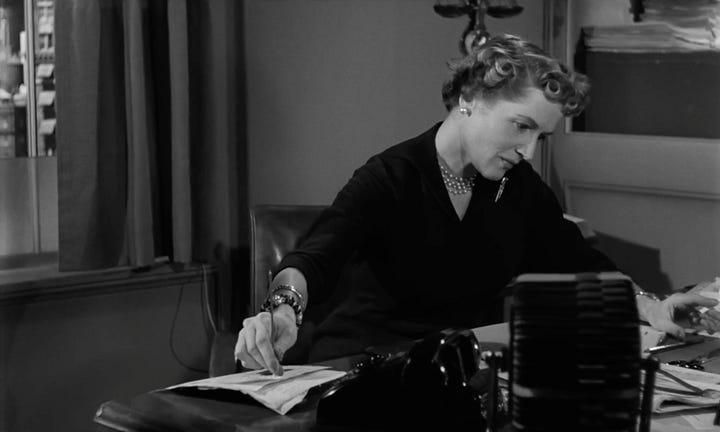How Different Camera Moves Hit Different Notes
SWEET SMELL OF SUCCESS demonstrates how constant camera moves versus sudden moves from stillness can draw our attention differently
Today we look at two camera movements from Sweet Smell of Success; one small-but-distinct move within still shots, and one scene where the camera makes constant, slower moves throughout.
First the singular move; it comes at 0:35, but it’s worth watching the scene prior for context (as well as acerbic wit).
A stack of papers is shown in the prior ‘table-establishing’ wide, in fact JJ (Burt Lancaster) strikes his match on the ashtray as though to draw attention to them.
This sort of attention to detail isn’t just good for visuals, but actors.
During the medium-two-shot the stack of papers are just on the edge of frame, which is particularly stark and noticeable in high-contrast black-and-white cinematography.
When Sidney (Tony Curtis) reaches for the papers, the camera moves and tilts to highlight them:
It’s a dramatic movement, fitting of a dramatic film, and ‘punches home’ the significance to the viewer, while implying the others at the table (who are at the approximate point of view of the camera here) are noting them.
There’s a similar but far more subtle move in Parasite (2019).
Though the effect on the viewer is more likely subliminal, both films bring the item to the forefront of the viewer’s consciousness, and emphasise its importance to the characters / moment / story.
There’s plenty more than one way to bring the audience’s attention to an item. You could do a POV crash-zoom. You could cut to a closeup. Or you could incorporate its effect on the characters in a oner, as our next Sweet Smell of Success scene does.
This scene also centres around important papers, but has an entirely different feel than the first scene, as does the camera. Instead of biting, angrily sparring dialogue of Sidney and JJ, here Sidney and Mary (Edith Atwater) are casual and convivial, playing a social game while demonstrating their long-running and (mostly) comfortable relationship.
Just like Sidney, the camera is always restless and roving; though there are cuts, even within the actors’ singles, the camera keeps moving and reframing, making it feel more like a continuous scene than a typical ‘shot reverse shot.’
Sidney is going a mile a minute, so even if we don’t consciously notice the camera isn’t constantly ‘breaking’ the pace, we feel it.
Meanwhile the papers are always ‘there’ - clockwise in the gallery below:
Sidney thirstily looks at the papers; Mary studiously ignores him and them
After Sidney moves around the desk, the camera moves to reframe him, which also clearly position the papers in the foreground
Mary moves the papers closer to him; the camera moving with her
Sidney finally gets his hands on them
Check the video at from 0:51 for Tony Curtis’s literal handwringing before he reaches for them; it could read as nerves, or to dry sweat from his fingers, but also reads as greed. Curtis had to fight for the role of Sidney, and his magnificent performance was his big breakout.




This dolly-and-pan movement is reminiscent of how Raiders of the Lost Ark smoothly propels us through a packing scene. It doesn’t have to be a oner . . . . but isn’t it lovely how it is?1
Choreographing the actors’ movement with the camera means - assuming everyone hits their marks and the light and the focus is kept consistent and nobody blows a line and props cooperate, just little things - we the viewer are even more able to get ‘swept up’ in the action.
-
These moves work across genres from an action-adventure to psychological thriller social satire to melodrama, so why don’t we see them more?
Costing more time also costs more money.
A long move is a lot more work (at least up front, sometimes overall) than several different shots. Your actors and grips alike have to know the lines and be good at hitting their marks, and if one of them has had a big night and is hungover or got bad news that morning or is just having an off day, it can start pushing the mood on set to mutiny by take eight which doesn’t work.
Even those small moves can be difficult, not just in 1957 with car-sized cameras, but with modern technology too; these moves require precision and often three-to-five people working in sync.
It’s all a gamble because if you spend hours lighting and blocking and it doesn’t work, you’re well sunk. Doing dramatic sweeping moves for a big dance number or opening scene is one thing, but as a director you’ll often need to justify (to producers if not crew) why you NEED this complex a setup for ‘just’ a conversation between a gossip columnist and a secretary.
A dramatic camera move to an item can fail technically, but also creatively; COPPOLA DROP
But when it works, it’s magic: a thing of beauty, effective for the viewer, and hella fun for everyone.
IMDB
Stu talks about this in “Exposition and Invisible Oners” looking at shots from Jaws (1975), Mad Max (1979) and Thunderheart (1992)
INSERT COLLATED LINK HERE



